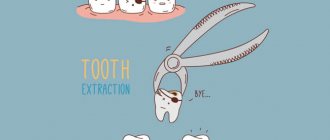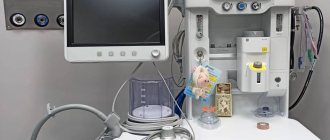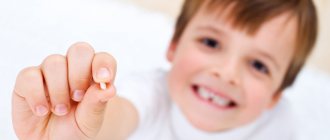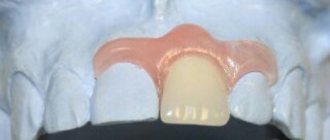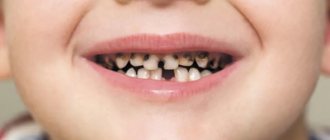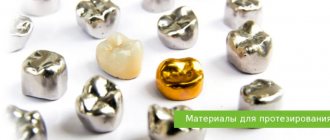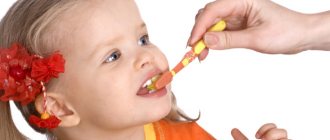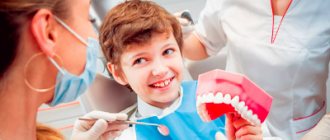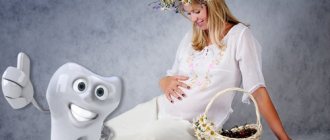- home
- Services
- Dental treatment under anesthesia in children
Most modern parents understand the importance of treating baby teeth, but do not want to expose their child to stress, which is why they postpone a visit to the dental clinic. Persuading an active child to sit in the dentist's chair is not an easy task, and if you wait until he grows up and realizes the importance of the problem, then there is a risk of losing time and teeth.
If the scope of work is such that it requires long and painstaking work of a specialist, then the choice in favor of treatment using anesthesia is obvious.
Dental treatment under anesthesia in children is recommended in the following cases:
- if there is a large amount of caries damage and several teeth need to be treated at one time;
- strong gag reflex and increased salivation;
- there is an allergic reaction to local anesthetics;
- neurological and mental diseases, cerebral palsy, autism;
- heart disease;
- panic fear of going to the dentist;
- tendency to hysterics;
- inability to reach an agreement during a game or conversation;
- ineffectiveness of local anesthesia.
The world's leading dentists have long stated that the use of anesthesia is a necessity in pediatric dentistry. According to the order of the Ministry of Health of the Russian Federation No. 946n, sanitation of the oral cavity in children under 3 years of age should be carried out under anesthesia.
Anesthesia and sedation in dentistry for children: what is the difference
Aza&Buka pediatric dentistry in Moscow provides treatment under general anesthesia or sedation.
- Anesthesia is a drug-induced sound, quiet sleep, during which the child rests and does not feel manipulation of the teeth. A pediatric dentist under general anesthesia will easily cure caries, pulpitis, remove milk or permanent units, and install a crown. During sleep, the patient is under the supervision of an anesthesiologist and connected to the best monitoring system. Dental treatment under general anesthesia for children is possible only after preparation and exclusion of contraindications.
- Sedation is treatment during sleep or in a pleasant relaxed state, when the nervous system does not react to external stimuli, and all medical manipulations are perceived calmly. Sedation during dental treatment in children is harmless and safe, suitable for patients with special health conditions or fear of dentists. The choice of drug and mandatory examination are agreed upon with the attending physician at the initial appointment.
Indications for removal of baby teeth
In children aged 6-7 years, the process of natural tooth replacement begins, the roots of baby teeth gradually dissolve, the crowns become loose and fall out on their own.
In some cases, the help of a dentist is still required:
- caries in an advanced stage, when tooth restoration is not possible;
- tooth decay caused by trauma;
- the crown of the tooth is already loosened, but does not fall out, causing discomfort to the child and injuring the gums;
- The permanent tooth has already begun to emerge, but the milk tooth is still firmly seated and does not make room;
- orthodontist recommendations for the formation of a correct bite;
- fistula, periodontitis, cyst.
Removal of incisors is most often associated with fractures and chips caused by trauma.
Dentistry under anesthesia for children: drugs used
Aza&Buka pediatric dentistry offers treatment under general anesthesia and sedation in Moscow - prices depend on the chosen drug and method.
- Anesthesia (Sevoran). Dental treatment for children under anesthesia in Moscow is carried out using the safe drug Sevoran. It is allowed even for the tiniest babies - from birth. Inhalation anesthesia Sevoran quickly puts the patient into artificial sleep, guarantees easy awakening, and does not cause allergies. The drug is administered using a laryngeal mask. The price for dental treatment for a child under general anesthesia in Moscow is affordable, the results are always excellent.
- Sedation (Propofol). Deep sedative dental treatment in children involves putting them to sleep with Propofol. The anesthetic is recommended for patients over 10 years of age. The procedure does not require the insertion of tracheal tubes, the patient breathes on his own, and the drug is administered intravenously. During sleep, the doctor can work on the child’s teeth under anesthesia - treat them, place crowns - or perform an extraction. Healthy and well-rested children go home calmly after treatment.
- ZAX in dentistry - treatment with nitrous oxide, superficial sedation. The patient receives a nitrogen-oxygen mixture through a special mask, which does not cause drowsiness. The child is calm, relaxed, hears the doctor’s requests and responds to them. At the same time, the baby completely lacks fear, stiffness or tension. Dental treatment under sedation for children is fun and comfortable, accompanied by watching cartoons or interesting stories. Recommended age: from 3 years.
The doctor decides whether to treat a child’s teeth under anesthesia or sedation after diagnosing the oral cavity and meeting the patient.
Pediatric anesthesia for dental treatment: requirements for the clinic
Many Moscow dentists offer anesthesia, but not every clinic has its own anesthesiologist. In some centers, the doctor works part-time and comes only for specific appointments. This is an unsuccessful option for patients, since the doctor does not have the full amount of necessary equipment, a nurse with specialized education, or normal conditions for carrying out manipulations.
The right choice for parents is a licensed clinic with all the necessary specialists on staff. The benefits are obvious:
- Constant contact with the patient's family. Parents meet with the anesthesiologist several times. They clarify all the questions: what kind of anesthesia is used to treat children’s teeth, how to prepare, what to do before and after.
- Qualified team. During treatment, the child is accompanied by an anesthesiologist, a nurse anesthetist, a pediatric dentist and his assistant.
- Availability of monitoring equipment. During medicated sleep, the patient’s condition is monitored not only visually, but also programmatically – through a cardiac monitor and pulse oximeter.
- Own department and comfortable offices. The child prepares for the procedure in a comfortable environment, and emerges from anesthesia in a specially prepared room.
Marina Dolotova The
Azabuka Clinic is fully equipped to treat children while they sleep. We have the best equipment, proven drugs and the best pediatric doctors in Moscow. They trust us and bring their children - and this is better than any reviews.
Treatment of children under anesthesia in dentistry: indications
The planned dental procedures are painful - removal of several teeth, complex treatment.- The duration of the required treatment is when a large amount of work needs to be completed in one session.
- Fear of dentists - a categorical refusal to treat teeth, tears, hysterics.
- Negative experience of previous appointments - a small patient panics and cannot trust the doctor.
- Restlessness – Hyperactive children benefit greatly from nitrogen sedation dental treatment.
- Allergic reactions - if the dentist cannot use local anesthetics.
- Inability to establish contact with the child - neurological diagnoses, developmental features.
- Low pain threshold - in case of increased sensitivity, a pediatric dentist under anesthesia will be a real salvation.
If the child is over 2 years old
If there is a need for outpatient dental care under general sedation, children over two years of age are sent to public dental clinics where such treatment is possible: a license, highly qualified specialists and equipment.
Indications:
- Caries of several teeth
- Dental phobia, fear of dental treatment, increased anxiety and emotional excitability.
- Allergies, intolerance to drugs used for local anesthesia.
Required research:
- general blood test with hemosyndrome (valid for 10 days);
- biochemical blood test according to indications (valid for 10 days);
- general urine test (valid for 10 days);
- electrocardiogram (valid for 1 month)
- ECHO cardiogram of the heart (according to indications)
- blood type and Rh factor (indefinitely).
- conclusions of a pediatrician and otolaryngologist
List of clinics:
Children's Dental Clinic N 28
- Address: General Ermolov str., 12
- Districts: Eastern Administrative Okrug, ZAO
Children's dental clinic N 30
- Address: 3rd Frunzenskaya st., 6
- Districts: Central Administrative District, Southern Administrative District, South-Western Administrative District, South-Eastern Administrative District
Children's dental clinic N 41
- Address: Skhodnenskaya st., 52
- Districts: Northern Administrative Okrug, North-East Administrative Okrug, North-Western Administrative Okrug, Zelenograd
Contraindications
- Age (no restrictions, from 3 or 10 years) - treatment of dental caries for a child under general anesthesia or sedation is selected according to the age of the patient. Each drug and method has its own age restrictions, and this is taken into account first of all.
- Allergic reaction - to chicken protein (Propofol), to components of the drug Sevoran, intolerance to certain compounds.
- Infectious diseases are a temporary limitation for the treatment of children's primary teeth under sedation.
- Exacerbation of chronic diseases - dental treatment under a mask for a child is allowed after the relapse has resolved.
Local
Since pediatric dentists use local anesthesia most often, we will dwell on it in more detail. This method gives a good analgesic effect, but does not make the treated area completely insensitive. Has a small number of contraindications.
Effective local anesthesia options:
- Applique. The weakest in terms of the severity of the resulting analgesic effect. An anesthetic gel is applied to the gums (most often it includes lidocaine). The active compounds of the drug quickly penetrate the tissues and dull their sensitivity. The application helps to numb the injection site. It is also sufficient if you have to remove a very loose baby tooth.
- Injection. The most popular medications in the field of pediatric dentistry are those containing articaine. They are injected into the gums using a syringe. This remedy is much stronger than novocaine, but has fewer side effects. It can be used from the age of four. Doctors use conduction and infiltration injection anesthesia - the choice of technique depends on the characteristics of the disease. In the first case, the injection is made in the branch of the trigeminal nerve, in the second - in the border of the transitional fold and the alveolar process. Conduction anesthesia can only be performed on patients over six years of age.
Stages of treatment in sedation and anesthesia
- Arrival at the clinic and adaptation in the playroom. Comfortable communication with the children's doctor in the presence of parents, a pleasant atmosphere, cartoons and funny dental stories. While walking around the clinic, the patient is led to the desired room.
- Smooth descent into sleep. The child is asked to try on a special mask, after which the patient falls asleep and is comfortably placed on a chair. If dental treatment with a mask is planned, children are started to be given Sevoran; if not, they are transferred to intravenous anesthesia Propofol. To monitor your well-being, the anesthesiologist connects the necessary equipment.
- Treatment under Sevoran. A team of doctors carries out the necessary treatment of dental diseases - filling or removing teeth, performing surgical operations, placing crowns. The anesthesiologist monitors the child's condition. Parents wait in the hall or in a separate office.
- Diagnosis and treatment. If it was not possible to assess the condition of the oral cavity earlier, the doctor will do this immediately after the child falls asleep. If the clinical picture is clear, treatment begins immediately. A team of doctors works with each patient to quickly and efficiently carry out all dental procedures and minimize anesthesia time.
- Awakening. Modern drugs guarantee rapid recovery of consciousness. The patient wakes up 15-20 minutes after the anesthesia is turned off - again surrounded by parents and familiar faces.
- Monitoring the condition and going home. The patient is observed by a doctor for about half an hour after waking up. If the baby is feeling normal, he is allowed to go home with his parents, having previously given the adults a memo with recommendations.
Nitrogen sedation in pediatric dentistry is performed as part of a routine appointment after short-term adaptation.
Nitrous oxide
Dental treatment with nitrous oxide for children is the simplest and safest method of inhalation sedation, which relieves stress and moderate fear during dental procedures. The history of the use of ZAKS, a mixture of gases N2O and O2, goes back more than 150 years. This type of anesthesia is still used by dentists in Europe, America and Israel.
The child is in a relaxed state and in a good mood, while he is conscious and all his reflexes are preserved: he breathes independently, can move, and answer questions.
The sedative mixture is supplied in the following order:
- during direct communication, the doctor suggests wearing a mask, this may be part of some kind of game;
- first, the child breathes oxygen, then nitrous oxide is added to the mixture until it reaches a concentration of 30%;
- treatment is carried out under the control of devices;
- after the end, oxygen again replaces N2O;
- then the mask is removed.
After just 10 minutes, there are no traces of gas inhalation left in children's lungs.
Advantages of the method:
- complete absence of side effects;
- the action begins after a few breaths;
- the effect of inhaling the substance quickly disappears and the patient returns to his usual state;
- it is a safe alternative to deep anesthesia;
- the degree of sedation is easily controlled using modern electronic-automatic equipment.
- Disadvantages of the method
- These include the inability to use this type of anesthesia at a young age, when the child does not want (or resists breathing independently through a mask throughout the entire treatment) Therefore, the method is indicated for children over 5-6 years of age.
Nitrous oxide can be used in combination with local anesthesia to enable the administration and enhance the effect of painkillers.
Children's dental clinic Aza&Buka: treatment under anesthesia or sedation
When parents are looking for where they can treat their child’s teeth under general anesthesia or sedation, they consider all the clinics’ offers. There are many reasons to choose Azabuka pediatric dentistry:
- Honest prices - administrators will not just tell you how much it costs to treat a child’s teeth under anesthesia or sedation, but will also name mandatory and secondary related services.
- All types of dental care - in the clinic you can remove a child’s baby tooth under sedation, cure pulpitis and caries, and put crowns on damaged teeth.
- Experienced doctors - the children's dental center employs highly qualified specialists of various profiles to provide excellent services to young patients.
- Individual approach - all the clinic staff are familiar with the peculiarities of child psychology, which helps to establish contacts even with difficult patients.
- The little patients are in an excellent mood - after treatment without pain and tears, the children leave happy and with healthy teeth.
- Modern equipment - for diagnosis and treatment, health monitoring, drug supply, comfortable service.
Dentistry Aza&Buka - healthy teeth from birth!
How safe is general anesthesia?
At the RuDenta Kids clinic, all risks during anesthesia are minimized thanks to the use of reliable, internationally recognized German Drager equipment and the most modern inhalation drug - the anesthetic sevoran, monitoring all vital functions of the child during the operation in accordance with Harvard standards. And, of course, thanks to the uninterrupted attention of the anesthesiologist to your child throughout the entire treatment procedure. To deliver the anesthetic to the lungs, we use a laryngeal mask, which, unlike traditional tracheal tubes, is less traumatic and does not cause soreness in the throat after the procedure.
Reviews from parents and impressions of children
Irina
Dental treatment for a child under anesthesia is very exciting for parents. My daughter is only 4.5 years old, so I was looking for the best specialists. And I found it. Many thanks to the anesthesiologist at the Azabuka clinic, dentists and all the staff. Everything went just fine and with minimal stress for the parents. Thank you for helping!
I put Aza&Buka:
5
Anna
Alexandra and Evgeniy
We often visit Aza&Buka dentistry - we regularly bring our children for preventive appointments and dental examinations. I like the warm, even bright atmosphere in the offices and corridors, and especially the doctor. The clinic’s doctors are excellent specialists and even better psychologists. They easily negotiate with children, they immediately became friends. We recommend!
I put Aza&Buka:
5
Zhenya
Irina
The first appointment was planned in detail: we talked with our daughter, watched the video website. Lisa really liked the funny characters Aza and Buk, and at the appointment she only talked about them with the doctor. I decided that I would take care of my teeth like Aza and sat calmly in the chair throughout the entire appointment. Great idea, great execution. And the doctors are just great.
I put Aza&Buka:
5
Dasha
Svetlana
We were looking for a sincere and good doctor for our Vasya. The diagnosis of cerebral palsy often became a reason for refusal. The child is complex, the doctors could not find an approach. We have already started thinking about treatment under anesthesia. Aza&Buka dentists offered sedation, treatment while half asleep - they kindly and calmly agreed with the child. The teeth were cured quickly - without whims or fear. Thank you!
I put Aza&Buka:
5
Vasya
If the child is under two years old or has a concomitant pathology
For children under 2 years of age and children with concomitant pathologies, dental care with general anesthesia is provided in a hospital setting.
Indications:
- Caries of several teeth
- Nervous system disease
- Defects of the craniofacial region
- Heart defects
- Bronchial asthma, pulmonary dysplasia, etc.
- Intolerance to treatment under local anesthesia
- Fear of dental treatment, increased emotional excitability
What is needed for the hospital:
- General blood test with hemosyndrome (valid for 10 days)
- biochemical blood test according to indications (valid for 10 days)
- General urine test (valid for 10 days)
- HIV (valid for a month)
- blood test for hepatitis B and C (valid for 1 month)
- blood type and Rh factor (indefinitely)
- electrocardiogram (valid for 1 month)
- ECHO cardiogram of the heart (according to indications)
- conclusions of a pediatrician, otolaryngologist, and other doctors, if prescribed by an anesthesiologist-resuscitator
List of hospitals:
Scientific and Practical Center for medical care for children with developmental defects of the craniofacial region and congenital diseases
- Address: Aviatorov str., 38
- Districts: Western Administrative District, Southern Administrative District, South-Western Administrative District, North-Western Administrative District. All districts in the presence of a congenital disease of the nervous system and a defect of the craniofacial region
Children's City Clinical Hospital of St. Vladimir
- Address: Rubtsovo-Dvortsovaya str., 1/3
- Districts: Eastern Administrative District, North-East Administrative District, South-East Administrative District. All districts in the presence of general somatic pathology, except cardiovascular
Children's City Clinical Hospital No. 13 named after N.F. Filatov
- Address: Sadovo-Kudrinskaya St., 15, (outpatient department, Zoologicheskaya St., 15)
- Districts: Central Administrative District, Western Administrative District, Zelenograd. All districts in the presence of cardiovascular pathology
The service is performed
Plaksina Margarita Mikhailovna
Rodikova Tatyana Yurievna
Soldatenkova Alina Aleksandrovna
All doctors
